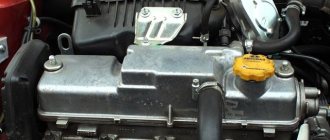On the Internet you can find a lot of information about engines installed on Lada Vesta. Among them are three domestic ones (two 1.6-liter versions and one 1.8-liter), as well as an engine from the Renault-Nissan concern with a volume of 1.6 liters and a power of 110 horsepower. But in fact, at the beginning of 2022, you can find only two of the listed options in car dealerships:
- A domestically developed engine with the index 21129, already familiar from other Lada car models. Thanks to the modernization of the previous version of this engine, the power increased by 8 hp. and is 106 “horses”.
- VAZ 21176 is also a domestic engine, developed quite recently and already quickly gaining popularity. The power of such a unit is 122 horsepower with a volume of 1.8 liters.
The domestic engine 11189 and the Japanese power unit HR16 are not currently installed on Vesta.
VAZ 21129
One of the answers to the question of what engine is in the Lada Vesta will be the VAZ-21129 engine, which develops a power of 106 “horses” (5800 rpm) and a torque of 148 Nm (4200 rpm). This unit is also installed on Priora, Lada Kalina 2 and Lada Granta cars.
The engine has two camshafts and 4 valves for each of the 4 cylinders. This unit is quite light - only 110 kg. Fuel injection type – distributed. The fuel consumption of the Lada Vesta with such an engine is 7 liters per 100 km in the combined cycle - this is a fairly economical option for the power it has.
The engine is equipped with two types of gearboxes: manual transmission and domestically developed AMT. The VAZ-21807 manual gearbox recently replaced the French JH analogue installed earlier. The AMT robotic gearbox (automatic manual transmission) has been installed on Ladas for several years now.
Engine in Lada Vesta
LADA Vesta is a long-awaited Russian-made passenger car that belongs to class B. The production of this model in various trim levels began back in 2022 and since then it has held its position in the top best-selling cars on the domestic market.
Big changes in the new model, first of all, affected what is under the hood of the car - the engine. In this article you can thoroughly familiarize yourself with the technical characteristics of LADA Vesta engines.
VAZ 21176
The VAZ 21176 engine gives another answer to the question of what engine is in the Lada Vesta. This is the second AvtoVAZ unit with a working volume of 1.8 liters. The first was developed back in the last century and was installed on five-door Nivas.
The predecessor of this “engine” is the VAZ-21126, which is still in use today. In addition to the added 200 “cubes”, a phase adjustment mechanism within 30 degrees was introduced into the motor. This technology is new among Tolyatti power units. The essence of this technology is that now the timing mechanism can move in different directions depending on the operating conditions of the unit. This occurs due to the fact that the pulley is no longer rigidly tied to the hub and can move relative to it using hydraulics.
The engine also set a record for “horses” among units installed on Ladas - its power is 122 hp. Fuel consumption in the combined cycle is 7.3 l/100 km.
Lada Vesta engine life - you need to know
Life tests of the units installed on Vesta allow us to say that the overall impression of them is rather good.
New Lada: Model range LADA Largus
We have already mentioned what resource the factory installs in the description of each motor; here we will briefly write:
— VAZ 21129 resource — 200,000 km; — motor life of the VAZ 21179 engine is 300,000 km; — resource hr16de from Nissan — 250,000 km.
Tuning is available in a wide variety of designs. Excellent options for tuning measures to improve driving characteristics would be the installation of a lightweight crankshaft and forward air flow. You can install an additional turbine; after modification, you need to improve not only the engine, but also other components of the car.
The main malfunctions and ways to eliminate them are:
1. An unpleasant whistle under the hood - most likely the timing belt has stretched and is close to breaking. It is better to replace if possible;
1.1 Unpleasant bubbling noise under the hood - the hr16de chain may have stretched and requires attention; 2. The engine stalls regularly for no apparent reason - a likely scenario is that the relay in the ignition unit has failed. It can be repaired during a recall campaign for defective vehicles; 3.
At medium speeds, a characteristic nasty sound occurs - the gasket in the exhaust pipe has burned out or is burning out. Replacement is easy, especially if you contact the ASC; 4. The appearance of such a phenomenon as vibration - in VAZ engines this is a design flaw associated with the right airbag. Replace and the problems will disappear.
5. Increased fuel consumption, unstable operation, sluggish acceleration from more than 15 to hundreds - the oxygen concentration sensor (lambda probe) may be broken.
VAZ-11189
This version of the “engine” was installed on the first batches of Lada Vesta cars, but later began to be actively used in the Lada Largus line. The difference between this engine and the VAZ-21116 “engine” is the original VAZ pistons (remember, American Federal Mogul pistons are installed in the 21116), as well as mounted units and modified supports.
The unit develops a power of 87 horsepower, and the low power does not create any inconvenience, especially when driving in city conditions. The engine displacement, as on most Ladovsky engines, is 1.6 liters, and fuel consumption is practically no different from its older 1.8-liter “brother” - about 7.2 liters per 100 km in the combined cycle. The engine has one camshaft and two valves for each cylinder.
Thanks for subscribing!
At the moment, Vesta is not equipped with the 11189 engine due to the slight difference in production costs with the more powerful analogue 21129.
What kind of gasoline should I fill according to the recommendations?
The regular Vesta and the SW modification with the listed types of internal combustion engines can be operated on AI-92 and 95 gasoline. At the same time, fuel with a lower octane number (AI-92) can be poured in case of urgent need.
In practice, many drivers refueled their cars with 98-octane gasoline. After using this brand of fuel, no negative changes in the operation of the internal combustion engine were noticed.
However, higher octane slightly improved driving dynamics and reduced consumption. The 16 and 18 year old engines are more suitable for domestic fuel.
Renault-Nissan HR16/H4M
At the end of 2016, the power unit from the Renault-Nissan concern is installed only on cars of the Lada X-Ray line. Rumors about plans to introduce the “engine” under the hoods of Vest remain just rumors for now. Perhaps the manufacturer does not yet consider it necessary to install it in the new Vestas for the reason that they already have 106 and 122 hp engines in their configurations. By the way, the power of the HR16 produced by AvtoVAZ is 110 horsepower. The engine is installed in many Nissan vehicles. Among them are such popular models as Note, Micra, Tiida, Juke, Wingroad and many others.
If you want to find out what engine is installed on the Lada Vesta, pay attention to the model of the power unit indicated in the registration certificate. If this is not possible, determine by appearance - there are many photos and videos of each motor on the Internet.
Engine hr16de-h4m
The HR16DE-H4M is a powerplant jointly produced by Nissan and Renault.
AvtoVAZ received permission to produce this power unit in Russia in 2022. The engine not only has a number of advantages over the previous ones, but also has disadvantages. The main advantage of the HR16DE-H4M is its undemandingness regarding the type of fuel. The car will drive great both on the AI-95 and on the cheaper AI-92. The manufacturer also did not dare to install an unreliable belt and decided to install a strong chain.
The main disadvantage is the lack of hydraulic compensators. This is inconvenient, because every 100 thousand kilometers you will have to adjust the gaps. The HR16DE-H4M is not equipped with AMT - only a CVT and manual transmission.
It was also noticed that foreign-made engine mounts for LADA Vesta wear out quickly, which causes knocking and noise.
Real indicators based on reviews from car owners
The standard 1.6-liter engine is paired with a 5-speed manual transmission and a robot. The quality of the transmission as a whole does not cause any complaints from owners. Also, drivers often wonder what kind of gasoline is best to fill in the Lada Vesta? The manufacturer recommends refueling only with 95-octane gasoline; this information can be found in the vehicle documentation. This is important to take into account, because the nominal resource was determined taking into account many indicators, in particular, taking into account the octane number of the fuel.
TRANSMISSIONS
In this regard, AvtoVAZ also offers a wide choice. The main gearbox will be a 5-speed manual, which is also installed on other VAZ models. In 2012, it was modified, some components were replaced, Japanese and German parts were supplied, the volume of oil poured was reduced, and other work was carried out. As a result, the gearbox is quieter, shifts have become more convenient, and vibrations have decreased.
Technical characteristics of Lada Vesta gearboxes.
The Lada Vesta will not receive a classic automatic transmission, which has upset many visitors to dealer showrooms. Its place was taken by a “robot” of the AMT type, due to its low cost of production, created on the basis of a manual gearbox bearing the index 2180. Despite the rougher work (small jerks and jolts when switching), the use of components from the world companies ZF and VALEO, coupled with less appetite and no need to warm up, the robot has a real chance of becoming a worthy alternative to an automatic transmission.
Weight of Lada Vesta engines and gearboxes.
In addition, the Lada Vesta will also receive a CVT, which will be transferred to the domestic sedan from the Japanese model Nissan Tiida. However, there is no more complete information on it yet.
Nominal filling volumes of Lada Vesta (in liters).
Engine 21179
AvtoVAZ was the first to introduce variable valve timing and use selective assembly on a conveyor belt. The 1.8-liter engine (122 hp) is not very different in appearance from the current VAZ sixteen-valve engines.
Updated engine parameters 21179:
- Throttle valve without mechanical drive.
- The cylinder head has additional oil channels for the phase regulator and lightweight Mahle valves.
- The catcollector is supplied by Russian, the diameter of the input channels is increased to 39 mm, the oxygen sensor bears the Bosch emblem.
- Crankshaft with increased crank radius.
- The working volume of the cylinders has “increased” due to the larger piston stroke.
- A reliable high-performance water pump is purchased from the Korean company GMB.
- For the first time, a VAZ has installed an imported GMB oil pump with increased performance.
- A new automatic timing belt tensioner with two rollers from the German company INA was used.
- Lightweight connecting rod and piston group manufactured by Federal Mogul.
- The fuel rail, injectors with increased productivity, and the spray pattern are optimized for the workflow of the new engine.
Specifications
Making the right choice when buying a car will be much easier with a deeper knowledge of the characteristics of this engine.
Features of the power unit 21179:
| Engine capacity, cc | 1774 |
| Maximum power, hp | 122 — 145 |
| Maximum torque, N*m (kg*m) at rpm. | 170 (17) / 3700 187 (19) / 3600 |
| Fuel used | Gasoline AI-92 Gasoline AI-95 |
| Fuel consumption, l/100 km | 6.8 — 7.9 |
| engine's type | In-line, 4-cylinder |
| Add. engine information | Electronic fuel injection |
| Number of valves per cylinder | 4 |
| Maximum power, hp (kW) at rpm | 122 (90) / 5900 122 (90) / 6050 145 (107) / 6200 |
| Supercharger | No |
Advantages and disadvantages
Even the leaders of the global automobile industry do not have ideal cars. Potential buyers will be interested in what the main advantages and disadvantages of this car are compared to old AvtoVAZ models and other cars presented in this price category. It is the ratio of pros and cons, expressed by differences in technical characteristics and convenience parameters, that primarily influences the consumer’s choice.
Positive features of the engine:
- Oil pump with increased power.
- Imported camshafts are lightweight.
- The cylinder head received additional oil channels that deliver fluid to the new phase shifter.
- The cooling system has been improved, an imported water pump of greater power with high reliability indicators has been used.
- The systems are controlled similarly to the VAZ 21127 model through DBP and DTV, and not through the previously familiar mass air flow sensor, which also has a positive effect on the reliability and stability of operation.
- The domestically produced intake tract was made specifically for the characteristics of the new power unit.
- The new engine is adapted for the use of cheaper fuel with an octane rating of AI-92.
- Maximum power - 122 hp. s., torque - 172 N/m. The engine received a flat torque plateau, which allows it to achieve a torque of 127 N/m at 1000 rpm, which is 7 N/m higher than the maximum performance of the base VAZ 11183 engine.
Despite the positive aspects, the engine of this car has its disadvantages.
Engine disadvantages:
- The engine is a modification of the 16-valve Priora engine. For some, it rattles when not warmed up or at idle, and often whistles. Such a whistling sound is generally characteristic of such a motor, so you can simply ignore it.
- The weak link of such engines remains the electrics: some complain about the gas pedal, starts on the 2-3rd attempts, even when it’s warm, and unstable idle. A Vesta with a Euro-5 engine only needs high-quality gasoline; bad fuel can cause hang-ups and bent valves.
- The new 1.8 engine for Vesta may surprise you with increased oil consumption at the start of driving. There was a theory that the cause could have been poorly processed Chinese valve stems, which AvtoVAZ quickly replaced with others, thus eliminating the problem.
Which engine oil is best for LADAVesta?
Let's talk about the first of two Russian models. There are quite a few differences between the 129 engine and the 127 Priorovsky, the youngest in the model range. In comparison with the VAZ-11186 engine, with a volume of 1.6 liters, it has a power of 106 horsepower. This difference is due to 16 valves instead of 8 in the previous version. Ambient temperature sensors and absolute pressure sensors are installed as standard. Characteristics of this Lada Vesta engine.
Power - 106 horsepower, spins up to 5800 rpm. Volume - 1.6 l. A highly modernized engine mount has been installed. Drive and timing type: standard DOHC timing belt. Torque characteristics - 1484200. Motor weight - 109.2 kg. Cast iron cylinder block Electronic ignition system controlled by a processor.
Adds dynamics to the car. Fuel type is unleaded gasoline with an octane rating of 95, but 92 is also possible. Power supply is via a distributed injection system. The car will accelerate to 100 km/h from 21129 in 12.8 seconds. With a 129 engine, Vesta consumes gasoline: in the city - 10.2 liters, mixed driving - 7.5 liters, on the highway - 6.2 liters.
Toxicity is at a level characteristic of the Euro 5 standard.
The running life is set at 200 thousand km.
Innovations compared to the design of the previous model monitor the quality of fuel, and do not idle. The damper system regulates the air supply at different speeds, which gives traction to the engine from the bottom and at the top.
— a cylinder block with increased rigidity is installed, and other engine systems are improved. Compared to previous models, it shows an increase in quality indicators and meets European quality standards;
— the piston has one oil scraper ring and two thin compression rings, which reduces loss of performance due to friction;
— extensive opportunities for improving the power unit, tuning increases power to 145-150 hp.
The only noticeable drawbacks of the 129 engine are the high, uneven tone noise level. It may appear after prolonged use and at the very beginning. When the timing belt breaks, like most VAZ engines, it suffers from the fact that the valves bend.
This engine option was the first in the line with a volume of 1.8 liters. produced since 2016. Externally similar to competitors, but inside there are a lot of design features characteristic of the 179 model. Vesta with a 1.8 liter engine installed 21179. is much more dynamic and powerful than his less productive colleagues.
Power - 122 horsepower, spins up to 6050 rpm. The most powerful of our line. Volume - 1.8 l. It is assembled using a selective conveyor method. Drive and timing type - a German device from INA is installed for tensioning a toothed belt. The belt will need to be replaced after about 90 thousand km.











